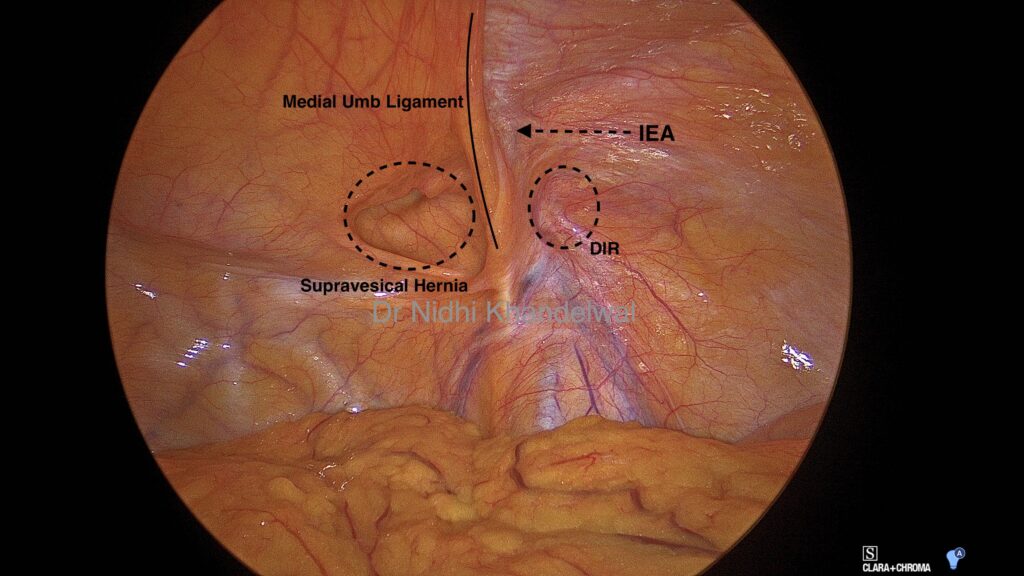
Robotic and Laparoscopic Groin Hernia Surgery can be of various types. So how do you choose what is best for you? Let’s discuss!
Overview of Laparoscopic and Robotic Surgery
Laparoscopic or Robotic surgery, also known as minimally invasive surgery, involves making small incisions through which a tiny camera and specialized instruments are inserted in order to complete the surgery. In Laparoscopy, the surgeon herself or himself holds the instruments and completes the operation. However, in Robotic Surgery, the Robot holds the instruments and the surgeon then controls the robot. This makes Robotic Surgery more precise.
TAPP (Trans Abdominal Pre Peritoneal) Groin Hernia Surgery
In TAPP surgery, the surgeon accesses the hernia site by going through the abdominal wall. They then push the hernia back into place and reinforce the area with a mesh to prevent recurrence.
Watch a Video of Laparoscopic TAPP Groin Hernia Surgery by Dr Nidhi Khandelwal:
TEP (Totally Extra Peritoneal) or ETEP (Enhanced Totally Extra Peritoneal) Groin Hernia Surgery
TEP surgery involves creating a space between the abdominal wall and the peritoneum (the lining of the abdominal cavity). Through this space, the surgeon repairs the hernia and secures a mesh to strengthen the weakened area.
Advantages of Laparoscopic and Robotic Surgery
Laparoscopic and Robotic Groin Hernia Surgery offers several benefits over traditional open surgery. Some of these are:
- Less Scarring: With Minimally Invasive surgery, scarring is minimal as only small incisions are made, leading to more cosmetically pleasing results compared to larger incisions required in open surgery.
- Faster Recovery: Patients undergoing Laparoscopic or Robotic surgery typically experience a much quicker recovery compared to open surgery. This means less time is spent in the hospital, and a faster return to daily activities and work.
- Reduced Risk of Complications: Due to their minimally invasive nature, Laparoscopic and Robotic surgery carry a lower risk of complications such as wound infections, bleeding, and nerve damage when compared to traditional open surgery.
Which type of Groin Hernia Surgery is Best for me?
Every Laparoscopic Robotic Surgeon considers a lot of variables when he/she is offering a particular Groin Hernia Surgery to you. Factors such as the size and location of the hernia, as well as the patient’s overall health, will be taken into consideration by the surgeon when determining the most appropriate approach.
Effectively, both procedures have similar results and outcomes. The risk of recurrence is very low with all 3 Groin Hernia Surgeries, and the safety is maximal. So sit back and relax while your surgeon does what she or he knows best.
Consultation with a Surgeon: If you’re considering Laparoscopic or Robotic Groin Hernia Surgery, it is essential to consult with a qualified surgeon who can assess your individual case and recommend the most suitable treatment option.
Conclusion
- Laparoscopic and Robotic Groin Hernia Surgery offers a minimally invasive approach to repairing hernias, with options such as TAPP, TEP and ETEP at your disposal. all of this offer the benefits of smaller incisions, faster recovery times, and reduced risk of complications.
In summary, if you’re facing the discomfort of an inguinal hernia, laparoscopic surgery could be the solution you’ve been searching for. Consult with a qualified surgeon to explore your options and take the first step towards a hernia-free future.
Click on the following link to learn more:
https://drnidhikhandelwal.com/wp-content/uploads/2023/07/Hernia-surgery.pdf

